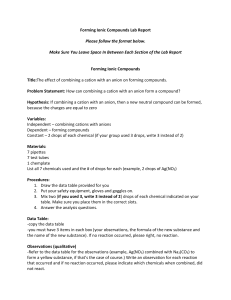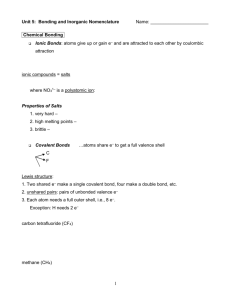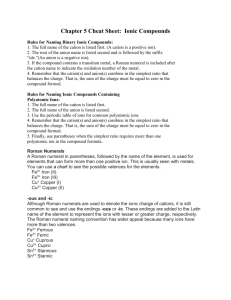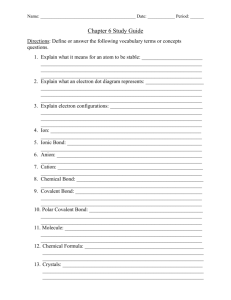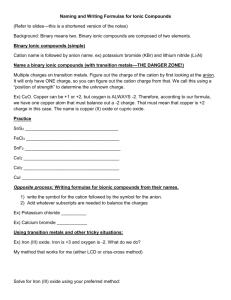Grocery Store Nomenclature Activity
advertisement
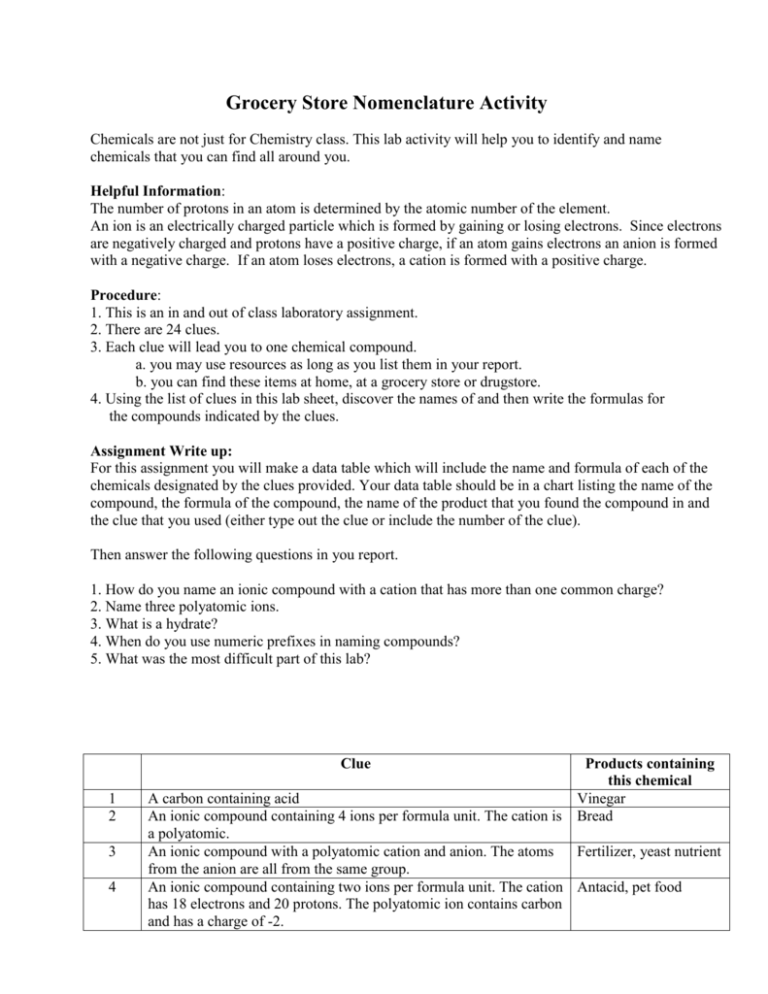
Grocery Store Nomenclature Activity Chemicals are not just for Chemistry class. This lab activity will help you to identify and name chemicals that you can find all around you. Helpful Information: The number of protons in an atom is determined by the atomic number of the element. An ion is an electrically charged particle which is formed by gaining or losing electrons. Since electrons are negatively charged and protons have a positive charge, if an atom gains electrons an anion is formed with a negative charge. If an atom loses electrons, a cation is formed with a positive charge. Procedure: 1. This is an in and out of class laboratory assignment. 2. There are 24 clues. 3. Each clue will lead you to one chemical compound. a. you may use resources as long as you list them in your report. b. you can find these items at home, at a grocery store or drugstore. 4. Using the list of clues in this lab sheet, discover the names of and then write the formulas for the compounds indicated by the clues. Assignment Write up: For this assignment you will make a data table which will include the name and formula of each of the chemicals designated by the clues provided. Your data table should be in a chart listing the name of the compound, the formula of the compound, the name of the product that you found the compound in and the clue that you used (either type out the clue or include the number of the clue). Then answer the following questions in you report. 1. How do you name an ionic compound with a cation that has more than one common charge? 2. Name three polyatomic ions. 3. What is a hydrate? 4. When do you use numeric prefixes in naming compounds? 5. What was the most difficult part of this lab? Clue 1 2 3 4 Products containing this chemical Vinegar Bread A carbon containing acid An ionic compound containing 4 ions per formula unit. The cation is a polyatomic. An ionic compound with a polyatomic cation and anion. The atoms Fertilizer, yeast nutrient from the anion are all from the same group. An ionic compound containing two ions per formula unit. The cation Antacid, pet food has 18 electrons and 20 protons. The polyatomic ion contains carbon and has a charge of -2. 5 6 7 8 9 10 11 12 13 14 15 16 17 18 19 20 21 22 23 24 Both the cation and anion each have 18 electrons, but different number of protons. The cation’s positive charge is twice as big as the charge of the anion. An ionic compound that contains five ions per formula unit. The cation has 18 electrons. An ionic compound containing two ions per formula unit. The cation has 18 electrons. The -2 charged, polyatomic anion contains 5 atoms one of which is sulfur. An ionic compound containing two ions per formula unit. The cation contains 27 electrons. The -2 charged, polyatomic anion contains 5 atoms, one of which is sulfur. The anion is polyatomic, but consists of just one type of atom. The cations have no electrons. An ionic compound containing two ions per formula unit. The cation contains 24 electrons. The -2 charged, polyatomic anion contains 5 atoms one of which is sulfur. An ionic compound containing two ions per formula unit. The cation has 10 electrons The polyatomic ion is -2 charged and contains 5 atoms one of which is sulfur. An ionic compound containing two ions per formula unit. The cation contains 23 electrons. The -2 charged, polyatomic anion contains 5 atoms one of which is sulfur. An acid with three hydrogens at the beginning of the formula. The one cation and one anion each have 18 electrons. An ionic compound with 2 ions per formula unit. The anion has 3 times as many electrons as the cation. A molecular compound containing three atoms per molecule. The total number of protons is 30. Remember no ions in this one. The polyatomic ion contains elements 1, 6 and 8. The cation has 10 electrons. The anion has 5 atoms and has a common name different from its systematic name. Check your reference page. The cation ion has 10 electrons. There are two ions per formula unit in this compound. The -1 anion has 8 more electrons than the cation. A binary ionic compound in which the anion and cation both have 10 electrons. An ionic compound with a cation consisting of 10 electrons and a polyatomic ion with 26 electrons. An ionic compound that contains 3 times as many cations as anions. The cation has 10 electrons and the anion is polyatomic. A molecular compound containing three atoms per molecule. The total number of protons is 32. An ionic compound containing 2 ions per formula unit. The cation contains 28 electrons. The atoms in the polyatomic ion are in the same group on the periodic table. Pickled products, olives Yogurt Bread Pet food Antiseptic, hair color lightener Pet food, plant nutrient, spaghetti Laxative, soaking agent Pet food Soft drinks Soup Iodized table salt Bouillon cubes Croutons, salty snacks Cookies Table salt, salted snacks Toothpaste Bleach Cleaning products, yogurt Fig Newtons Pet food
